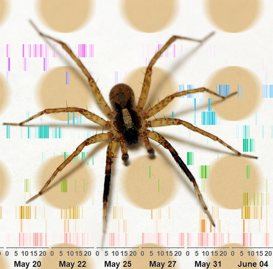| Spider Courtship Decoded by Machine Learning |
| Written by Janet Swift |
| Sunday, 07 April 2024 |
|
Using machine learning to filter out unwanted sounds and to isolate the signals made by three species of wolf spider has not only contributed to an understanding of arachnid courtship behavior, but has also accelerated the development of the new discipline of soundscape ecology. As a statistician, or in today's terminology, a data scientist, from time to time you get the opportunity to collaborate on projects well outside your own area of expertise. OK, sound ecology is too new for me to have been asked for help and increasingly researchers without any maths or computing are able to take advantage of machine learning to tackle almost any type of data collected in almost any scenario. In the case of the research reported here the scenario was a deciduous forest and the data was audio, specifically substrate-borne vibratory signals. The study, an analysis of the resulting vibroscapes, and which was reported in a recent issue of Communications Biology, falls within the remit of the new subfield of "soundscape ecology", which uses sound recording technology to collect and quantify biological, geophysical, and anthropogenic sounds over in natural communities. Until now soundscape ecology has predominantly focused on the collection and classification of airborne sounds and has overlooked the substrate-borne acoustical environment, Noori Choi, one of the paper's authors, writes: Such a narrow focus greatly constrains our understanding of soundscape ecology, as it ignores the most diverse and representative species in a community. For instance, many arthropods, a major taxonomic group of most ecosystems, predominantly communicate using substrate-borne vibrations. Such signaling is unfortunately not captured by most airborne sound sensors. To remedy this, Choi, then a doctoral student at the University of Nebraska-Lincoln, set out to study three species of Wolf Spider, Schizocosa stridulans, S. uetzi, and S. duplex. This involved placing an array of 25 tiny, cheap contact microphones and creating 20 pitfall traps across 1,000-square-foot sections of forest floor in North Mississippi and waiting for data to accumulate. Then back Lincoln needed to sift through 39,000 hours of data including over 17,000 series of vibrations. Initial analysis led Choi to record: “The vibroscape is a busier signaling space than we expected because it includes both airborne and substrate-borne vibrations.” Luckily Choi didn't need to rely on manual effort to separate the sounds of other insects and birds, of wind interacting with tree branches and anthropogenic noise pollution from overhead planes. Instead he designed a machine learning program capable of filtering out unwanted sounds while isolating the vibrations from three separate wolf spider species: Schizocosa stridulans, S. uetzi, and S. duplex. This enabled him to identify the courtships songs of the three species of ground-dwelling Wolf spiders and provide new insights into arachnid behaviors, particularly an overlap of acoustic frequency, time, and signaling space between the S. stridulans and S. uetzi sibling species including the finding that both of them restricted their signaling for when they were on leaf litter rather than pine debris. Commenting on Choi's use of machine learning for the analysis of vibroscapes, his doctoral adviser Eileen Hebets, who is the George Holmes Professor of Biological Sciences at the University of Nebraska, said: “This is 100% novel. I think it’s going to open up avenues of research that people have been really trying to explore over the years — but just have never been able to get the door open. And I think Noori has fully opened it, and he put the doorstop in there, and now everybody can go through.” With machine learning and generative AI becoming ever more available We are likely to see this sentiment frequently repeated over the coming months and years. More Informationhttps://doi.org/10.1038/s42003-023-05700-6 Choi, N., Miller, P. & Hebets, E.A. Vibroscape analysis reveals acoustic niche overlap and plastic alteration of vibratory courtship signals in ground-dwelling wolf spiders. Commun Biol 7, 23 (2024) Spider conversations decoded with the help of machine learning and contact microphones Related ArticlesIdentifying Birdsong - A Kaggle Machine Learning Competition Can ML Unlock The Secrets of the Herculaneum Scrolls? To be informed about new articles on I Programmer, sign up for our weekly newsletter, subscribe to the RSS feed and follow us on Twitter, Facebook or Linkedin.
Comments
or email your comment to: comments@i-programmer.info
|
| Last Updated ( Sunday, 07 April 2024 ) |



